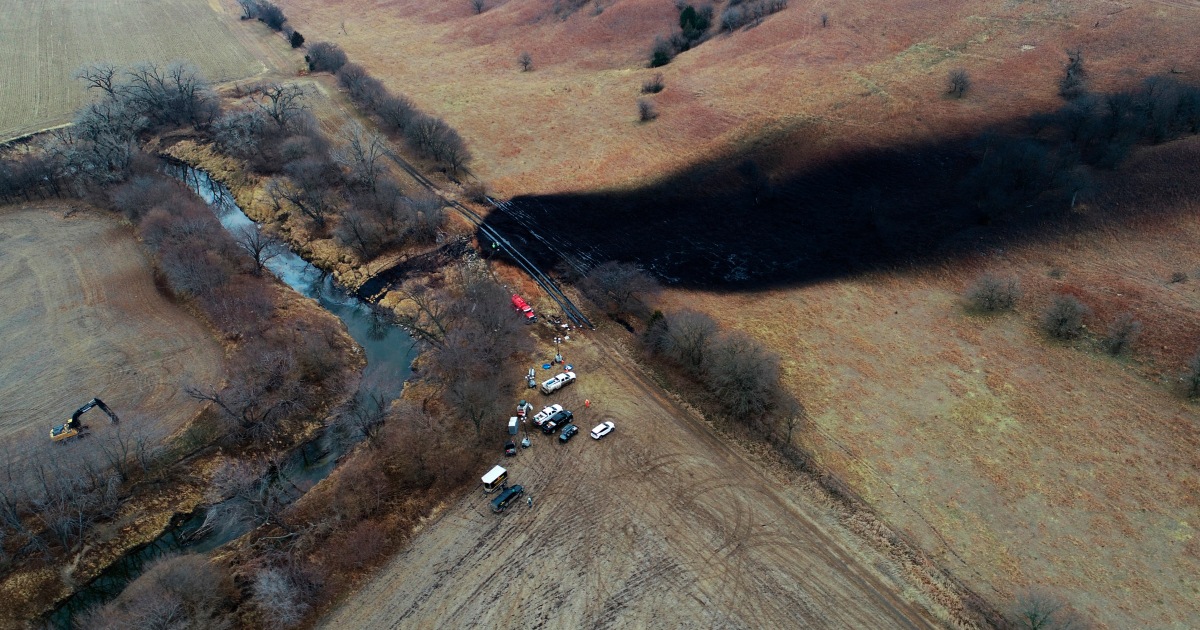The operator of the Keystone Pipeline System, which carries a form of crude oil from Canada to multiple states for refining, said over the weekend that its largest-yet breach has been contained for now.
The pipeline failure three miles east of Washington, Kansas, on Wednesday caused an estimated 14,000 barrels of crude, or 588,000 gallons of a form of crude known as tar sands oil, to spill into a natural waterway, Mill Creek, according to the U.S. Department of Transportation Pipeline and Hazardous Materials Safety Administration.
The administration has ordered the affected section of pipeline, about 160 miles north of Wichita, closed until corrective action can be completed.
TC Energy, the Canadian parent of day-to-day pipeline operator TC Oil, said in a statement Saturday that the spill was no longer moving downstream. It mobilized 250 crews to handle cleanup and has deployed booms and vacuum trucks to stop the oil, the company said.
The U.S. Environmental Protection Agency said in a statement Saturday, “The discharge has been contained, and no drinking water has been impacted.”
The failure along a 96-mile segment in parts of Washington County, Kansas, Clay County, Kansas and Jefferson County, Nebraska, brings renewed concern over pipeline safety following the demise of the contentious Keystone XL pipeline project.
That proposed pipeline, which would have carried Canadian oil sands to Nebraska, polarized U.S. political leaders, who mostly lined up either to kill it or make way. It was thwarted by the administration of President Barack Obama, renewed by President Donald Trump, and nixed by President Joe Biden. TC Energy withdrew its plans last year.
In the last five years there have been at least three significant spills along the original Keystone Pipeline System, Wednesday’s being the most voluminous, according to the Pipeline and Hazardous Materials Safety Administration.
The pipeline regulators also noted accidents and breaches in the Keystone system in 2011, 2016, and 2020. The affected section is part of the 288-mile Cushing Extension, completed in 2011, that takes crude from Steele City, Nebraska, to Cushing, Oklahoma, regulators said.
Environmentalists have argued that these incidents come with such a pipeline, and they’re not worth the convenience of more direct transportation for fossil fuel in a world coming to terms with global warming caused largely by burning it.
The Sierra Club said this was the 22nd time the pipeline it calls Keystone 1 was the site of a spill, breach or accident.
“There is no such thing as a safe tar sands pipeline and this is another disaster that continues to prove we must put our climate and our communities first,” Sierra Club’s Catherine Collentine said in a statement.
Many environmental organizations want Biden to prohibit any new oil and gas infrastructure on public lands.
Alan K. Mayberry, associate administrator at the Pipeline and Hazardous Materials Safety Administration, said in a letter to a TC Oil executive last week that the company is ordered to keep the affected segment offline.
Mayberry wants TC Oil to determine the root cause of the breach and name decision-makers who might have contributed to the spill, according to the letter dated Thursday. He also said the company should repair or replace any damaged or breached segments and consider if other part of the pipeline have similar conditions or structural issues.
Ahead of any restart, TC must reduce pressure to 80 percent of what it was right before the breach, the federal pipeline regulators said.
Wednesday night’s spill came as the company was conducting an analysis of the conveyance nearby by using an “in-line inspection tool,” according to Mayberry’s letter.
“The ILI tool is currently downstream of the failure location,” he wrote. “Respondent had bypassed the Hope, Kansas, pump station, the next station downstream, in preparation for the tool to pass when the failure occurred.”
Any possible cause and effect here wasn’t clear. The letter also suggests the failure involved “failed pipe joints.”
TC Energy said in a statement Friday that the pipeline was being run according to the rules. “At the time of the incident, the pipeline was operating within its design and regulatory approval requirements,” the company said.
During the tenure of President George W. Bush, TC Oil was granted special permission to use higher-than-standard pressure along the Cushing Extension to motivate the thick form of crude from Canada.
Bill Caram, executive director of the nonprofit Pipeline Safety Trust, told Associated Press that the number of Keystone spills, breaches, and accidents since then should prompt a reconsideration of allowing higher pressure.
“I think it’s time to question that,” he said.
Share your story or advertise with us: Whatsapp: +2347068606071 Email: info@newspotng.com
















